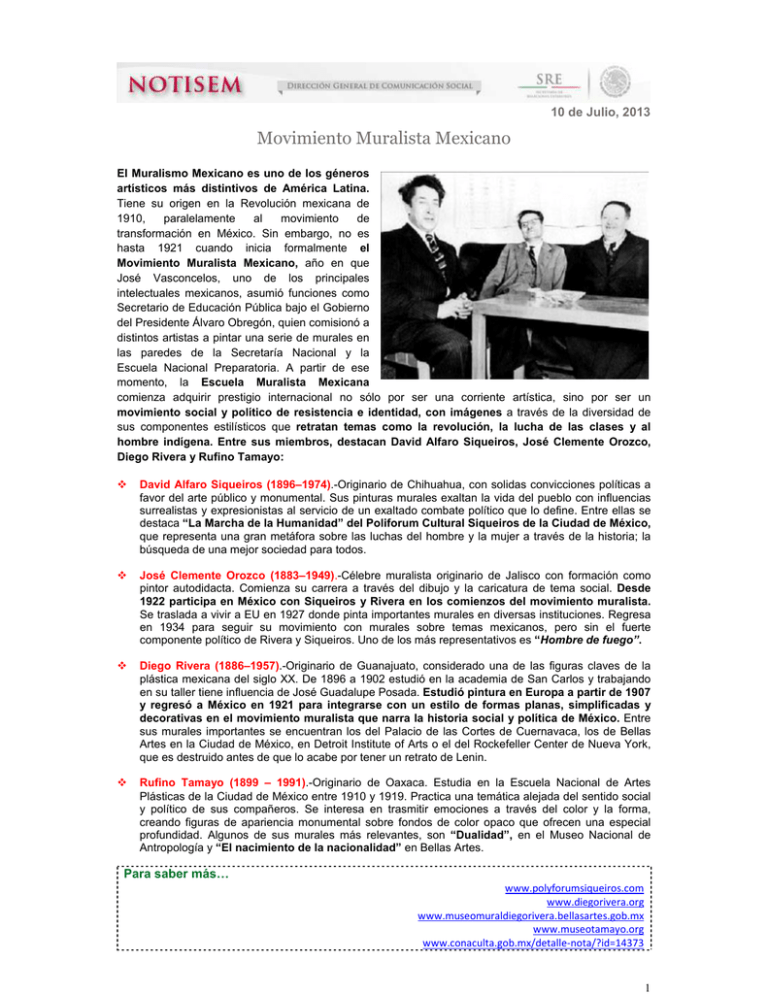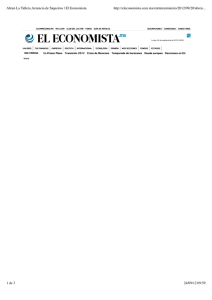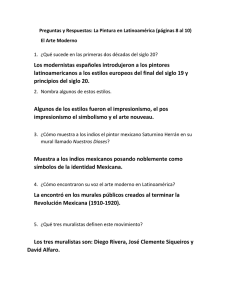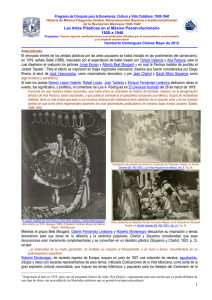Movimiento Muralista Mexicano
Anuncio

10 de Julio, 2013 Movimiento Muralista Mexicano El Muralismo Mexicano es uno de los géneros artísticos más distintivos de América Latina. Tiene su origen en la Revolución mexicana de 1910, paralelamente al movimiento de transformación en México. Sin embargo, no es hasta 1921 cuando inicia formalmente el Movimiento Muralista Mexicano, año en que José Vasconcelos, uno de los principales intelectuales mexicanos, asumió funciones como Secretario de Educación Pública bajo el Gobierno del Presidente Álvaro Obregón, quien comisionó a distintos artistas a pintar una serie de murales en las paredes de la Secretaría Nacional y la Escuela Nacional Preparatoria. A partir de ese momento, la Escuela Muralista Mexicana comienza adquirir prestigio internacional no sólo por ser una corriente artística, sino por ser un movimiento social y político de resistencia e identidad, con imágenes a través de la diversidad de sus componentes estilísticos que retratan temas como la revolución, la lucha de las clases y al hombre indígena. Entre sus miembros, destacan David Alfaro Siqueiros, José Clemente Orozco, Diego Rivera y Rufino Tamayo: David Alfaro Siqueiros (1896–1974).-Originario de Chihuahua, con solidas convicciones políticas a favor del arte público y monumental. Sus pinturas murales exaltan la vida del pueblo con influencias surrealistas y expresionistas al servicio de un exaltado combate político que lo define. Entre ellas se destaca “La Marcha de la Humanidad” del Poliforum Cultural Siqueiros de la Ciudad de México, que representa una gran metáfora sobre las luchas del hombre y la mujer a través de la historia; la búsqueda de una mejor sociedad para todos. José Clemente Orozco (1883–1949).-Célebre muralista originario de Jalisco con formación como pintor autodidacta. Comienza su carrera a través del dibujo y la caricatura de tema social. Desde 1922 participa en México con Siqueiros y Rivera en los comienzos del movimiento muralista. Se traslada a vivir a EU en 1927 donde pinta importantes murales en diversas instituciones. Regresa en 1934 para seguir su movimiento con murales sobre temas mexicanos, pero sin el fuerte componente político de Rivera y Siqueiros. Uno de los más representativos es “Hombre de fuego”. Diego Rivera (1886–1957).-Originario de Guanajuato, considerado una de las figuras claves de la plástica mexicana del siglo XX. De 1896 a 1902 estudió en la academia de San Carlos y trabajando en su taller tiene influencia de José Guadalupe Posada. Estudió pintura en Europa a partir de 1907 y regresó a México en 1921 para integrarse con un estilo de formas planas, simplificadas y decorativas en el movimiento muralista que narra la historia social y política de México. Entre sus murales importantes se encuentran los del Palacio de las Cortes de Cuernavaca, los de Bellas Artes en la Ciudad de México, en Detroit Institute of Arts o el del Rockefeller Center de Nueva York, que es destruido antes de que lo acabe por tener un retrato de Lenin. Rufino Tamayo (1899 – 1991).-Originario de Oaxaca. Estudia en la Escuela Nacional de Artes Plásticas de la Ciudad de México entre 1910 y 1919. Practica una temática alejada del sentido social y político de sus compañeros. Se interesa en trasmitir emociones a través del color y la forma, creando figuras de apariencia monumental sobre fondos de color opaco que ofrecen una especial profundidad. Algunos de sus murales más relevantes, son “Dualidad”, en el Museo Nacional de Antropología y “El nacimiento de la nacionalidad” en Bellas Artes. Para saber más… www.polyforumsiqueiros.com www.diegorivera.org www.museomuraldiegorivera.bellasartes.gob.mx www.museotamayo.org www.conaculta.gob.mx/detalle-nota/?id=14373 1 July 10, 2013 Mexican Muralist Movement The Mexican muralism is one of the most distinctive artistic genres in Latin America. It has its origin in the Mexican Revolution of 1910. However, it is until 1921 when it formally starts. At this time, Jose Vasconcelos, a leading Mexican intellectual, took office as Secretary of Public Education under the government of President Alvaro Obregón who commissioned different artists to paint a series of murals on the walls of the National Secretariat and the National Preparatory School. From that time on, the Mexican Muralism begins acquiring international recognition, not only as an artistic genre, but as a social and political movement of resistance and identity, with images through its diverse stylistic components that portray issues related to the revolution, the class struggle and Mexican indigenus people. Its members include David Alfaro Siqueiros, José Clemente Orozco, Diego Rivera and Rufino Tamayo: David Alfaro Siqueiros (1896–1974).-He was born in Chihuahua. He had strong political convictions in favor of public art and monuments. Its wall paintings exalt the life of the people with surrealist and expressionist influences, it exalts political struggles. Among these: "The March of Humanity" at the Siqueiros Cultural Polyforum at Mexico City, which is a great metaphor for the struggles of men and women throughout history and the pursuit of a better society for all. José Clemente Orozco (1883–1949).-Renowned self-trained muralist originally from Jalisco. He started his career through the drawing and caricature of social issues. Since 1922 he participated in Mexico with Siqueiros and Rivera in the early mural movement. He moved to the U.S. in 1927, where he painted murals in several important institutions. One of his most representative murals is the "Man of Fire". Diego Rivera (1886–1957).-Considered one of the key figures of twentieth-century Mexican art. Rivera born in Guanajuato, from 1896-1902 he studied at the Academy of San Carlos. He worked with José Guadalupe Posada in his workshop, which had great influence. He studied painting in Europe from 1907 and returned to Mexico in 1921. He returned exalting a style of flat shapes, simplified and decorative that chronicles the social and political history of Mexico. His greatest murals are at the Palace of Cortes in Cuernavaca, at the National Institute of Fine Arts in Mexico City, at the Detroit Institute of Arts or at the Rockefeller Center in New York, which was destroyed because it included a portrait of Lenin. Rufino Tamayo (1899 – 1991).-Originally from Oaxaca. He studied at the National School of Fine Arts between 1910 and 1919 in Mexico City. He practiced a theme away from the social and political meaning of their peers. He was interested in conveying emotions through color and form, creating monumental figures. Some of his most important murals are "Duality" at the National Museum of Anthropology and "The Birth of nationality" at National Institute of Fine Arts. For more information… www.polyforumsiqueiros.com www.diegorivera.org www.museomuraldiegorivera.bellasartes.gob.mx www.museotamayo.org www.conaculta.gob.mx/detalle-nota/?id=14373 2





